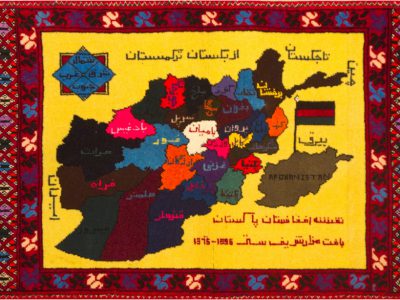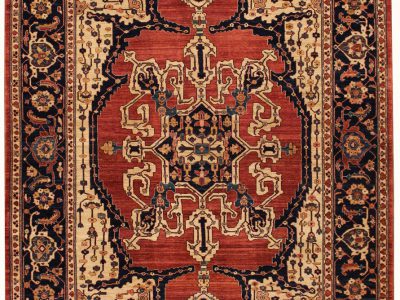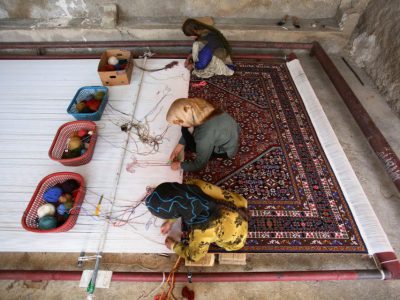The increasing demand all over the world for Afghan carpets, rugs and other piled goods, as well as killims has stimulated a lively interest in this time-honored craft. The production of Afghan woven good is extremely varied, and falls into two main classifications: namely the Turkoman and the Beloutch and the Beloutch-type. Both are produced by pastoral people of entirely different origin, yet who had the same needs and a constantly available source of wool. Thus, many of their products were made to serve similar purposes, though each is quite distinct in technique of weave, in color and design.
Not least of the charms of the Afghan carpet is that it is among the few products left the world today that is still made entirely by hand. Carpet production in Afghanistan is from beginning to end a cottage industry, and for the buyer, represents good value in terms of wear, beauty and adaptability to surroundings. Another characteristic of Afghan carpets is that they are wholly of wool and all designs are rectilinear.
The Turkoman Carpet
All Turkoman carpets are woven in the north of the country between Maimanah to the west and Kunduz to the east, apart from Sarouq carpets which are made in Maruchak and Mauris which are made in and around Herat in the west of Afghanistan. The word Mauri means “from Merv” the city in the Turkmenistan from which the weavers of these goods originated and include members of the Tekke, Yamoud and Sarouq tribes.
The wool used in Turkoman weaving is renowned in the trade for its lustrous and hard-wearing properties. It comes from the famous indigenous breed of Karakul sheep, which is equally renowned in the fur trade for its Karakul lambskins. The Karakul sheep is a fat-tailed breed having a dual fleece, that is, two types of wool growing simultaneously. The outer fleece has longer staples than the soft crinkly wool of the inner fleece, which when carefully sorted and blended produce ideal carpet wool.
Carding and spinning is carried out by hand, by both men and women. The balls of wool are made into skeins which are then dyed, either by the weaver’s family in its own compound or by professional dyers in the bazaar.
Though aniline dyes have been used since their invention at the turn of the century, there is now a growing tendency among the Turkomans to revert to the use of natural dyestuffs. Those most commonly used are madder, the root of a spindly bush which grows abundantly in many of the carpet-producing areas, for red; walnut peel for dark brown; pomegranate peel for light brown, and sparak, a wild flower from the steppes, for yellow. The blues in Turkoman carpets are generally indigo.
Weaving- traditionally on a horizontal loom – is usually done by women. All sizes of carpets and rugs, ranging from mats to runners to the “over-sizes”, are made throughout the year. Larger carpets, however, because they are usually woven in the open are mainly produced during the summer months.
The majority of Mauri carpets and rugs are of single weft, whereas in the main other Turkoman goods are double wefted. The Persian or Sennah knot is generally used.
When weaving a carpet, no set plan is followed: the design is entirely executed from memory – a testimony to the fact that Turkoman designs and symbols are of unknown age and representative of their own particular culture.
Most Turkomans in Afghanistan belong to the Ersari tribe, a large ethnic group sub-divided into clans, many of which have their own individual carpet motifs and designs whose origins and symbolic meanings are far from clear. Perhaps the two best-known designs are the “fil-poi” or elephant’s foot, a large octagonal gul and the smaller Tekke gul, or “Bukhara pattern” as it is now called in the trade, and within these motifs there is a wide variety. In addition, there is a large range of different Ersari designs. Other Turkomans who weave carpets in Afghanistan are the Tekkes, Yamouds and Sarouqs, who all have their distinctive weaves and designs.
Besides carpets and rugs, the Turkomans produce countless items made with wool for their daily domestic needs – wood and metal being unobtainable or difficult to come by. For example, the doorway of the yurt, the circular wood-framed tents in which Turkomans live, is closed by a type of carpet called a “purdah” (curtain), also called a hatchlou or Ensi, fringed at the bottom and having at the top a cord with which to tie it to the framework.
Other items still woven by the Turkomans for their daily use include:
- the juwal, often made in pairs is a large bag used for storing clothes or larger household goods, and was kept hung on the inside of the yurt. When migrating these bags were tied one on either side of the camel, whence the western name of “camel bag”. Though these are still made, only on very rare occasions, such as the escorting of the bride to her new home, will one see juwal on a camel;
- the khourgine or donkey bag, is still very much in use. This bag is in a joined pair and used as a saddle bag for horse or donkey, as well as over a man’s shoulder. These are also made in a flat weave.
- the torbah, a single bag, either knotted and piled or flat-woven, in different shapes and sizes according to is purpose, includes the much sought-after namak donne used for storing the rock-salt.
- Another decorative furnishing is the jallar, a woven bag hung over the inside entrance of the yurt, distinguished by its fringes and sometimes having long side-pieces, when it is called jallar poidar or jallar with legs.
The horse, especially prized and the camel have always been very much part of the traditional Turkoman way of life, consequently saddle cloths and various decorative trappings for these are still being made for everyday use.
Although this list is not conclusive, it is hoped that it will give some indication of the variety and richness of the woven items produced by the Afghan Turkomans.
The Beloutch and Beloutch-Type Carpet
Herat, in the west of Afghanistan, is the major marketing centre for a wide region where a large and varied production of carpets, rugs and flat-woven pieces, including killims, is woven; goods from this area are traditionally known as Beloutches. Some of the these goods are made by nomads and semi-nomads, many by people now sedentary who, though not strictly of the Beloutch tribe, have acquired some their techniques while imparting to their work their own tribal charm and rustic character which is so much sough-after today.
In such a large region, inevitable there is a broad variety of weaves and designs as well as types of wool used. Generally speaking, the majority of wool comes from the local strains of the Ghiljai and Gaadi breeds of sheep, whose soft wool readily develops a natural sheen though use. The Beloutch production, like that of the Turkoman, is entirely hand made, from shearing and spinning into dyeing and knotting. The Herat Beloutches are all wool as opposed to the Meshed Beloutches from Iran which have cotton warps. A wide variety of both chemical and natural dyestuffs are used.
Weaving, always on a horizontal loom, frequently takes place in the open under a shelter just outside the weaver’s tent, and is always done by women and girls who learn this craft when very young.
Besides carpets and rugs, the Beloutches, like the Turkomans, make knotted and piled bags of different shapes and sizes used for storage purposes. In addition they make baby cradles, saddle bags, harness for camel and donkey and sometimes horse, and all the numerous things required in daily life, as well as the decorative and functional pieces which play such an important role in betrothals, marriages, and dowries.
For the nomad of this area, the prayer rug or jai namaz is above all a vital need and is perhaps his most significant personal property. On this prayer rug, he, whose unsettled life, is a constant struggle with nature and the elements, makes his devotions to his Creator five times a day.
Killims are a flat-woven fabric made of wool. The variety of weaving techniques, of designs and colors is considerable, ranging from the simple yet charming striped killims of the Pasthun-speaking kouchis to the elaborate Beloutch killims of subtle design, often with decorative embroidery of great richness. The different types of killims made in this region are becoming very popular in Western markets, as are those of woven by Uzbeks, Turkomans and Hazaras in other areas of Afghanistan.
Flat-woven domestic pieces such as grain and flour sacks are also made in the Beloutch area, often with either woven or embroidered patterns, and bags of all shapes and sizes, sometimes highly decorated with cowrie shells, small mirrors, buttons and tassels.
All the items mentioned above are sought in the Western markets because they are both decorative and useful. For instance, killims can be used either as floor coverings (the purpose for which they were woven), wall hangings, bedspreads, etc. Donkey bags make excellent newspaper or knitting holders when draped over the arm of a chair. Juwals and the large torbahs when stuffed become striking floor or chair cushions. Tent bands enhance pelmets or curtains; camel halters and neckbands, the gaily decorated cradles and small bags make handsome wall ornaments, while a camel bell can be hung in many places, including outside the door.
Photos
Afghan Saffron
The reason for its hefty price is its labor-intensive harvesting method, making the production costly. Saffron is harvested by hand from the Crocus sativus flower, commonly known as the “saffron crocus.” The term “saffron” applies to the flower’s thread-like structures, or stigma.
Impressive Health Benefits
A Powerful Antioxidant: Saffron contains an impressive variety of plant compounds that act as antioxidants — molecules that protect your cells against free radicals and oxidative stress.
Notable saffron antioxidants include crocin, crocetin, safranal, and kaempferol.
Crocin and crocetin are carotenoid pigments and responsible for saffron’s red color. Both compounds may have antidepressant properties, protect brain cells against progressive damage, reduce appetite, and aid weight loss.
Safranal gives saffron its distinct taste and aroma. Research shows that it may help improve your mood, memory, and learning ability, as well as protect your brain cells against oxidative stress.
Lastly, kaempferol is found in saffron flower petals. This compound has been linked to health benefits, such as reduced inflammation, anticancer properties, and antidepressant activity.
Promotes learning and memory retention: Recent studies have also demonstrated that saffron extract, specifically its crocin, is useful in the treatment of age related mental impairment. In Japan, saffron is encapsulated and used in the treatment of Parkinson’s disease, memory loss and inflammation.
Protection against cold: Saffron is a stimulant tonic and very effective to treat cold and fever; saffron mixed in milk and applied over the forehead quickly relieves cold.
Food Additives: Saffron is an excellent replacement for synthetic food additives- for eg: instead of FD and C yellow no 5: a synthetic food coloring agent that is a very common allergy trigger, Saffron’s glorious yellow could be an acceptable hypoallergenic choice.
With these kesar benefits known to us, this culinary treasure has to be used and especially in the winter months. Here are some serving ideas:
1. For a wonderful marinade for fish, add saffron threads, garlic and thyme to vinegar.
2. Use saffron to give cakes, pastries and cookies a buttery golden hue and a rich aroma.
3. Cook biryanis with saffron combined with cloves, cinnamon, bay leaves for a memorable treat.
Fights Cancer: Studies have shown that cancerous rats treated with saffron aqueous extract showed improvement in their condition. And crocin, the compound in saffron, had inhibited the growth of colorectal cancer cells (while it left the healthy cells unaffected). It also had shown similar effects in the case of hepatic and prostate cancers. The spice had also played a major role in treating skin cancer.
Saffron is rich in carotenoids, which can contribute to its anticancer properties. Crocin in saffron can prevent breast cancer and leukemia. However, further research is warranted.
As per a report by the American Council of Science and Health, crocetin (a carotenoid related to crocin) in saffron can block the proliferation of two types of human cancer. It achieves this by inhibiting an enzyme that is particularly active in cancer cells. Though this may not brand saffron as a superb anticancer food, the spice does hold great promise.
According to another study, crocetinic acid (a purified compound from crocetin) has the potential to inhibit pancreatic cancer. In fact, the compound obstructs cancer stem cells – destroying them, which prevents the cancer from returning.
Improves Vision: A Spanish study states that the natural compounds in saffron can help prevent vision loss and retinal degeneration. Safranal, one of the compounds in the spice, was found to preserve photoreceptor morphology (the mechanism in the eyes that helps study the forms of things you see), visual response, and capillary network.
Saffron supplementation to ongoing treatment was found to improve macular thickness in patients. This significantly improves retinal function. Saffron was also found to prevent photoreceptor damage induced by chronic oxidative injury.
And as per a report by The University of Sydney, saffron was found to improve vision in the elderly. In the test, the patient’s vision had improved after taking saffron pills. Saffron affects the genes that regulate the fatty acid content of the cell membrane – and this makes vision cells more resilient. The study indicates saffron’s potential in treating retinitisc pigmentosa, a genetic disease that causes permanent blindness in young people.
Improves Vision: A Spanish study states that the natural compounds in saffron can help prevent vision loss and retinal degeneration. Safranal, one of the compounds in the spice, was found to preserve photoreceptor morphology (the mechanism in the eyes that helps study the forms of things you see), visual response, and capillary network.
Saffron supplementation to ongoing treatment was found to improve macular thickness in patients. This significantly improves retinal function. Saffron was also found to prevent photoreceptor damage induced by chronic oxidative injury.
And as per a report by The University of Sydney, saffron was found to improve vision in the elderly. In the test, the patient’s vision had improved after taking saffron pills. Saffron affects the genes that regulate the fatty acid content of the cell membrane – and this makes vision cells more resilient. The study indicates saffron’s potential in treating retinitisc pigmentosa, a genetic disease that causes permanent blindness in young people.
Promotes Digestion: Saffron was found to play a key role in promoting digestion and treating digestive disorders through its antioxidant effects and radical scavenging, and anti-inflammatory properties. It also shows potential in treating peptic ulcers and ulcerative colitis.
Improves Heart Health: Due to its antioxidant properties, saffron helps maintain healthy arteries and blood vessels. And the spice’s anti-inflammatory properties also benefit the heart. Saffron is the richest source of riboflavin, an important vitamin for the heart. The crocetin in the spice indirectly regulates blood cholesterol levels and reduces the severity of atherosclerosis.
Saffron can also lower blood pressure, which otherwise would lead to heart attacks.
May Reduce Appetite and Aid Weight Loss: Snacking is a common habit that may put you at risk of gaining unwanted weight.
According to research, saffron may help prevent snacking by curbing your appetite.
In one eight-week study, women taking saffron supplements felt significantly more full, snacked less frequently, and lost significantly more weight than women in the placebo group.
In another eight-week study, taking a saffron extract supplement helped significantly reduce appetite, body mass index, waist circumference, and total fat mass.
However, scientists are unsure how saffron curbs appetite and aids weight loss. One theory is that saffron elevates your mood, which in turn reduces your desire to snack.
May reduce heart disease risk factors: Animal and test-tube studies indicate that saffron’s antioxidant properties may lower blood cholesterol and prevent blood vessels and arteries from cloggin.
Easy to Add to Your Diet: In small doses, saffron has a subtle taste and aroma and pairs well with savory dishes, such as paella, risottos, and other rice dishes.
The best way to draw out saffron’s unique flavor is to soak the threads in hot – but not boiling – water. Add the threads and the liquid to your recipe to achieve a deeper, richer flavor.
Saffron is readily available at most specialty markets and can be purchased as threads or in powdered form. However, it’s best to buy the threads, as they give you more versatility and are less likely to be adulterated.
Though saffron is the most expensive spice in the world, a small amount goes a long way, and you often won’t need more than a pinch in your recipes. In fact, using too much saffron can give your recipes an overpowering medicinal taste.
In addition, saffron is available in supplement form.









